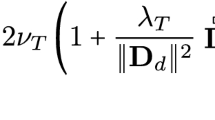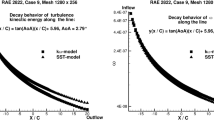Abstract
The turbulence closure problem where the objective is to find a model that captures the behavior of the Reynolds stress tensor has proved to be a huge challenge. The commonly employed Boussinesq hypothesis is known for some limitations in general problems, as discussed by Pope (Turbulent flows, Cambridge University Press, Cambridge, 2000). In the present work we employ a tensorial decomposition technique as a mean to evaluate the Boussinesq hypothesis. This methodology projects the anisotropic Reynolds stress tensor, obtained from a high-fidelity simulation onto the rate-of-strain tensor enabling an estimate for the turbulent viscosity and the error associated with the assumption. This approach is applied to two flow types corresponding to internal and external flows: a convergent–divergent channel flow and the flow around a sphere. The high-fidelity data are from a direct numerical simulation (DNS) for a convergent–divergent channel flow (available in the literature) and from a large eddy simulation (LES) performed in the present work for the flow around a sphere using the software OpenFOAM. An additional analysis is made regarding the detachment of the boundary layer in each flow using three Reynolds average Navier–Stokes (RANS) models: \(\kappa\)–\(\epsilon\); \(\kappa\)–\(\omega\); SST. Employing the software CFX for the numerical simulations employing RANS models, the behavior of the boundary layer was compared with the DNS/LES data in both flows. The results for the tensor decomposition theory have shown that the Boussinesq hypothesis is not sufficient to capture the Reynolds stress tensor in both flow types. It would be necessary to use an extended basis presented in this theory in order to have a better capture of the turbulence behavior in these flows. Regarding the boundary layer study, the results obtained showed to be reasonably accurate in regions where a viscometric flow is more likely to occur, in accordance with the literature.














Similar content being viewed by others
References
Pope SB (2000) Turbulent flows. Cambridge University Press, Cambridge
Gorlé C, Iaccarino G (2013) A framework for epistemic uncertainty quantification of turbulent scalar flux models for Reynolds-averaged Navier–Stokes simulations. Phys Fluids. https://doi.org/10.1063/1.4807067
Emory M, Larsson J, Iaccarino G (2013) Modeling of structural uncertainties in Reynolds-averaged Navier–Stokes closures. Phys Fluids. https://doi.org/10.1063/1.4824659
Kutz JN (2017) Deep learning in fluid dynamics. J Fluid Mech 814:1
Ling J, Jones R, Templeton J (2016) Machine learning strategies for systems with invariance properties. J Comput Phys 318:22
Zhang ZJ, Duraisamy K (2015) Machine learning methods for data-driven turbulence modeling. In: 22nd AIAA computational fluid dynamics conference. https://doi.org/10.2514/6.2015-2460
Wu J, Wang J, Xiao H, Ling J (2017) A priori assessment of prediction confidence for data-driven turbulence modeling. Flow Turbul Combust. https://doi.org/10.1007/s10494-017-9807-0
Thompson RL, Mompean G, Thais L (2010) A methodology to quantify the nonlinearity of the Reynolds stress tensor. J Turbul 11:1
Nieckele AO, Thompson RL, Mompean G (2016) Anisotropic Reynolds stress tensor representation in shear flows using DNS and experimental data. J Turbul. https://doi.org/10.1080/14685248.2016.1153106
Boussinesq MJ (1987) Essai sur la theorie des eaux courantes. Mem Pres Acad Sci XXIII:46
Launder BE, Sharma BI (1974) Application of the energy-dissipation model of turbulence to the calculation of flow near a spinning disc. Lett Heat Mass Transf 1:131
Wilcox DC (2008) Formulation of the \(k\)–\(\omega\) turbulence model revisited. AAIA J 46:2823–2838
Menter FR, Kuntz M, Langtry R (2003) Ten years of industrial experience with the SST turbulence model. Turbul Hear Mass Transf 4:625–632
Mitre J, Santana L, Damian R, Su J, Lage P (2010) Numerical study of turbulent heat transfer in 3D pin-fin channels: validation of a quick procedure to estimate mean values in quasi-periodic flows. Appl Therm Eng 30:2796
Smagorinsky J (1963) General circulation experiments with the primitive equations: I. The basic experiment. Mon Weather Rev 91(3):100
Wilcox DC (2006) Turbulence modeling for CFD, 3rd edn. DCW Industries, Incorporated
Thompson R (2008) Some perspectives on the dynamic history of a material element. Int J Eng Sci 46:224
Marquillie M, Ehrenstein U, Laval JP (2011) Instability of streaks in wall turbulence with adverse pressure gradient. J Fluid Mech 681:205–240
Stanislas M, Jimenez J, Marusic I (2009) Progress in wall turbulence: understanding and modeling, ERCOFTAC Series, vol 14. Springer, Berlin
Jones DA, Clarke DB (2008) Simulation of flow past a sphere using the fluent code. Report number: DSTO-TR-2232
Achenbach E (1972) Experiments on the flow past spheres at very high Reynolds numbers. J Fluid Mech 54:565
Sampaio LEB (2012) A transport-physics-accurate convection discretization based on first order upwind and the need for a new error assessment strategy. Comput Fluids 67:87
Acknowledgements
We would like to acknowledge CNPq, ANP and Petrobras for the financial support.
Author information
Authors and Affiliations
Corresponding author
Additional information
Technical Editor: Jader Barbosa Jr.
Rights and permissions
About this article
Cite this article
Ribeiro, B.L.R., Lopes, L.B.F., Mitre, J.F. et al. Model analysis of the turbulent flows in a convergent–divergent channel and around a sphere. J Braz. Soc. Mech. Sci. Eng. 40, 405 (2018). https://doi.org/10.1007/s40430-018-1324-0
Received:
Accepted:
Published:
DOI: https://doi.org/10.1007/s40430-018-1324-0




